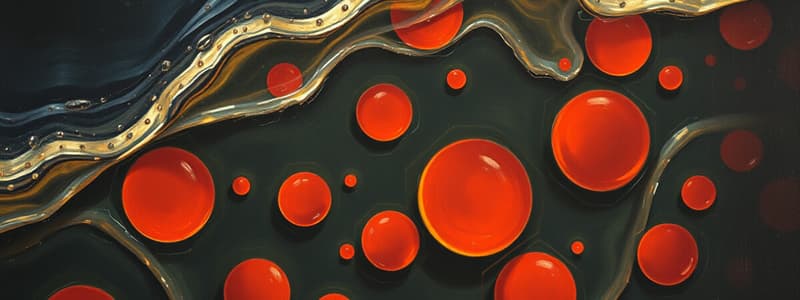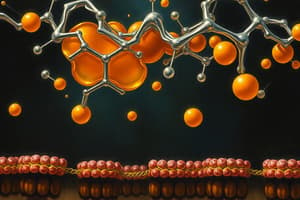Podcast
Questions and Answers
What is one of the primary roles of cholesterol in cell membranes?
What is one of the primary roles of cholesterol in cell membranes?
- To decrease membrane rigidity.
- To enhance membrane fluidity.
- To stabilize membrane structure. (correct)
- To increase membrane permeability.
Which condition is associated with an increased cholesterol content in erythrocyte membranes?
Which condition is associated with an increased cholesterol content in erythrocyte membranes?
- Spur cell anemia. (correct)
- Sickle cell anemia.
- Pernicious anemia.
- Hemolytic anemia.
Lipid rafts are primarily characterized by which of the following?
Lipid rafts are primarily characterized by which of the following?
- Heterogeneous and dynamic micro-domains. (correct)
- Low levels of sterols and sphingolipids.
- Enrichment in glycerophospholipids only.
- Static components of the cell membrane.
How does ethanol influence cell membranes in the nervous system?
How does ethanol influence cell membranes in the nervous system?
In the context of membrane fluidity, what is the consequence of increased intracellular cholesterol?
In the context of membrane fluidity, what is the consequence of increased intracellular cholesterol?
What are the defined types of lipid rafts as classified by Jacobson & Dietrich?
What are the defined types of lipid rafts as classified by Jacobson & Dietrich?
What effect do lipid rafts have on cellular processes?
What effect do lipid rafts have on cellular processes?
In severe liver disease, what happens to erythrocyte membranes related to fluidity?
In severe liver disease, what happens to erythrocyte membranes related to fluidity?
Which type of protein is described as having hydrophobic isoprene polymers covalently attached?
Which type of protein is described as having hydrophobic isoprene polymers covalently attached?
What is the primary role of lipid groups in lipid-anchored proteins?
What is the primary role of lipid groups in lipid-anchored proteins?
How does substrate presentation differ from allosteric regulation in enzymes?
How does substrate presentation differ from allosteric regulation in enzymes?
Which lipid-anchored protein type incorporates fatty acyl chains through thioester linkages?
Which lipid-anchored protein type incorporates fatty acyl chains through thioester linkages?
What specific types of isoprene are usually attached to prenylated proteins?
What specific types of isoprene are usually attached to prenylated proteins?
What happens to a protein during the process of substrate presentation?
What happens to a protein during the process of substrate presentation?
Which of the following roles do lipid groups NOT play in protein functionality?
Which of the following roles do lipid groups NOT play in protein functionality?
What determines the binding site of lipid groups on a protein?
What determines the binding site of lipid groups on a protein?
What is the primary role of sphingomyelins in the plasma membrane?
What is the primary role of sphingomyelins in the plasma membrane?
Which type of sugar is found in galactocerebrosides?
Which type of sugar is found in galactocerebrosides?
What characteristic of cholesterol helps alter membrane fluidity?
What characteristic of cholesterol helps alter membrane fluidity?
What type of bond links the sugar in glycosphingolipids to ceramide?
What type of bond links the sugar in glycosphingolipids to ceramide?
Which phospholipid is NOT one of the four major phospholipids in the animal plasma membrane?
Which phospholipid is NOT one of the four major phospholipids in the animal plasma membrane?
What is the significance of lipid mobility in the plasma membrane?
What is the significance of lipid mobility in the plasma membrane?
Which of the following best describes transverse diffusion of lipids in the membrane?
Which of the following best describes transverse diffusion of lipids in the membrane?
What type of fatty acyl group is present in ceramide?
What type of fatty acyl group is present in ceramide?
Flashcards are hidden until you start studying
Study Notes
Abnormalities of Cell Membrane Fluidity in Disease
- Cholesterol significantly influences membrane fluidity in mammals.
- Spur cell anemia results in erythrocytes with increased cholesterol, leading to spiny shapes and premature destruction in the spleen.
- This condition is commonly associated with severe liver diseases, such as alcoholic cirrhosis.
- Elevated intracellular membrane cholesterol impacts fluidity.
- Ethanol modifies membrane fluidity, potentially affecting membrane receptors and ion channels in the nervous system.
Lipid Rafts
- Lipid rafts are microdomains in the plasma membrane, proposed by Simons and van Meer in 1988.
- These rafts play a role in cholesterol transport from the trans Golgi network to the plasma membrane.
- Jacobson and Dietrich classified lipid rafts into three categories: caveolae, glycosphingolipid-enriched membranes (GEM), and polyphospho inositol-rich rafts.
- Defined at the 2006 Keystone Symposium as dynamic, sterol- and sphingolipid-enriched domains that compartmentalize cellular functions.
- They contribute to invasive properties of cells.
Sphingolipids
- Sphingolipids are based on sphingosine and dihydrosphingosine.
- Ceramides contain long chain fatty acyl groups linked to sphingosine.
- Sphingomyelins, abundant in mammalian tissues, have phosphorylcholine at C1.
- Glycosphingolipids have a sugar linked to ceramide, with cerebrosides as a subgroup (containing glucose or galactose).
- Galactocerebrosides are predominant in the brain, while glucocerebrosides are in limited amounts in non-neuronal tissues.
- Major phospholipids in animal cell membranes include phosphatidylcholine, phosphatidylserine, phosphatidylethanolamine, and sphingomyelin; their polar head groups may have varying charges at neutral pH.
Cholesterol
- Cholesterol is a crucial lipid in membranes, characterized as a compact, rigid hydrophobic molecule.
- Contains a polar hydroxyl group at C3, which influences membrane fluidity.
Mobility of Lipid Components in Membranes
- Lipid bilayers are flexible; lipid molecules rotate and diffuse laterally within leaflets.
- Phospholipids are mobile, capable of lateral movement and transverse diffusion.
- Lipid-protein interactions can be facilitated by lipids acting as mediators.
- Lipidation can sequester proteins away from substrates, leading to activation through substrate presentation.
- This process differs from allosteric regulation since it does not require conformational change of the enzyme.
Types of Lipid-Anchored Proteins
- Three main categories of lipid-anchored proteins exist:
- Prenylated proteins
- Fatty acylated proteins
- Glycosylphosphatidylinositol-linked proteins (GPI)
- Proteins may possess multiple lipid groups, with attachment sites influenced by both the proteins and lipid types.
Prenylated Proteins
- Contain covalently attached isoprene polymers at cysteine residues.
- Isoprenoid groups, such as farnesyl (15-carbon) and geranylgeranyl (20-carbon), are linked via thioether bonds at the protein's C-terminal.
- Prenylation enhances protein interactions with the cell membrane.
Studying That Suits You
Use AI to generate personalized quizzes and flashcards to suit your learning preferences.



